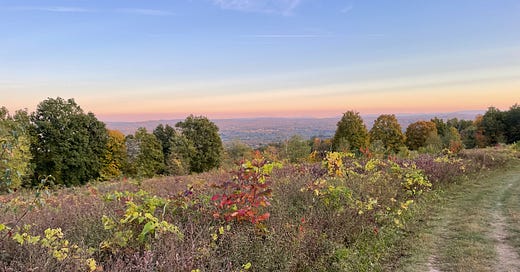Good morning.
I’m back in Austin after visiting my family on Long Island and then going to Upstate New York with my fiancee’s family for a little vacation. It’s been a busy couple days of travel so I’m a bit behind in keeping up with things.
But what a time to be in the Northeast! Nice part of the country we’ve got there.
And, because I love to take a dip, here’s a shot from a glorious October swim I got to take at one of my favorite places on the planet.
That swim gets the rare 💧 💧 💧 💧 💧 rating.
I may send another email later this week—or this may be it. Either way, there’s plenty to get to so let’s get to it.
In The Rebooting yesterday, Brian Morrissey wrote about the rise of the “indieverse” that’s been happening in publishing over the last several years.
Morrissey grounded his piece in a truth that I find a little too real sometimes: “Never before have so many people been famous that you have never heard of.”
I can’t tell you how many times my fiancee has been watching a video on TikTok and then I look over and go, “Who is that?” And she says, “just a person on TikTok.”
And a lot has been made of the strategy of both candidates in this election to shy away from traditional media appearances in favor of targeting specific audiences through the creators they follow.
There are a lot of people on TikTok! There are a lot of people on YouTube! There are a lot of people on Instagram! And a lot of them have thousands or millions of followers and are “famous” in a way that feels huge if you’re part of their universe. And yet they could remain completely unknown.
Look, Morrissey is a middle-aged man and at 39 I also qualify as middle-aged, so I’m sure there’s tons of cool stuff out there that we don’t know just because it isn’t for us or we’re just not plugged into dozens of the millions of little universes out there on the internet.
But that doesn’t mean that so many things that feel BIG are actually still kinda small.
Morrissey then takes a look at all the platforms and tools that have given rise to this “indieverse.” He notes mainly that what blogging lacked was Stripe. And that’s what platforms like Substack and others have now. Now, if you blog you can enter into the content marketplace and try to sell your product. Hopefully, you’ve found something you’re good at and you can stand out and make some money.
He concludes his piece with a sentiment that I completely believe in as the future for any established media brand.
“The creator economy was overhyped as a get-rich-quick tech scheme, but it was probably underhyped as a power shift in media. And there will be plenty of alliances. Look at what Vox is doing with its podcast studio. It is making deals with indieverse members. This is one of the underrated BuzzFeed screwups: it had the makings of a creator network.”
Because there are so many famous people you’ve never heard of. Because so many people creating things matter so much to some people but mean nothing to others, a media brand has to figure out who to partner with to survive and stay relevant.
And part of that is letting people be themselves and do their thing and figuring out creative ways to share money with them.
I wonder who will move fast enough and think creatively enough to figure it out.
One good quote
“Today, nearly half of the [New York Times] home page is programmed with assistance from algorithms that help promote news, features, and sub-brand content, such as The Athletic and Wirecutter. Some of these modules, such as the features module located at the top right of the home page on the web version, are in highly visible locations. During major news moments, editors can also deploy algorithmic modules to display additional coverage to complement a main module of stories near the top of the page.”
I’ve written about how websites stink and that the homepage is not ever really coming back. So I enjoyed this piece by Zhen Yang, a data scientist at the New York Times, that went deep on how cross-functional teams worked together to turn the New York Times’s homepage into an algorithmically driven product that better approximates how most platforms today work while also trying to maintain editorial (human editorial) input.
More links with human editorial judgment
Since we’re talking independent media, a trio of stories from the past week:
Kyle Chayka wrote a mini-profile of Taylor Lorenz tied to her decision to leave the Washington Post and start User Mag on Substack.
Delia Cai rounded up a slew of new independent publication news, including Tina Brown starting her own Substack.
Brian Morrissey (yes, again) wrote about what he’s learned after running The Rebooting for four years.
More on the New York Times: I found this little Adweek story about how The Athletic is partnering with Fubo to drive subscriptions to the streaming service to be the most interesting piece I read over the past week. As I’ve covered before, figuring out where and how to watch a game has become more challenging and driving people to a streaming service where they can watch the games in live game and other coverage is both a good service journalism idea and a new way to generate revenue. Smart stuff.
Over at Axios, Sara Fischer reports on the fact that more and more people are getting their news via creators on TikTok.
Speaking of TikTok, apparently that thing is pretty addictive!
Even more from Brian Morrissey: On the People vs. Algorithms podcast, he, Alex Schleifer, and Troy Young looked back on some “bad bets” in media and tech over the last decade or so.
Business Insider wrote about Substack’s investment in events. Key quote: “However, Substack isn't making money from these events. For now, it's all marketing and community building. So far, all of the events have been free for subscribers of the newsletters that are cohosting them.”
Hearst now has a deal with Open AI as well. Weird that this kind of story is already old hat at this point. Wonder if we’ll look back at all of these deals happening this year as the end of something and that we all just kind of shrugged and said, “Well, guess it had to happen that way.”
And here are two pieces on the state of culture that were kind of in conversation recently:




